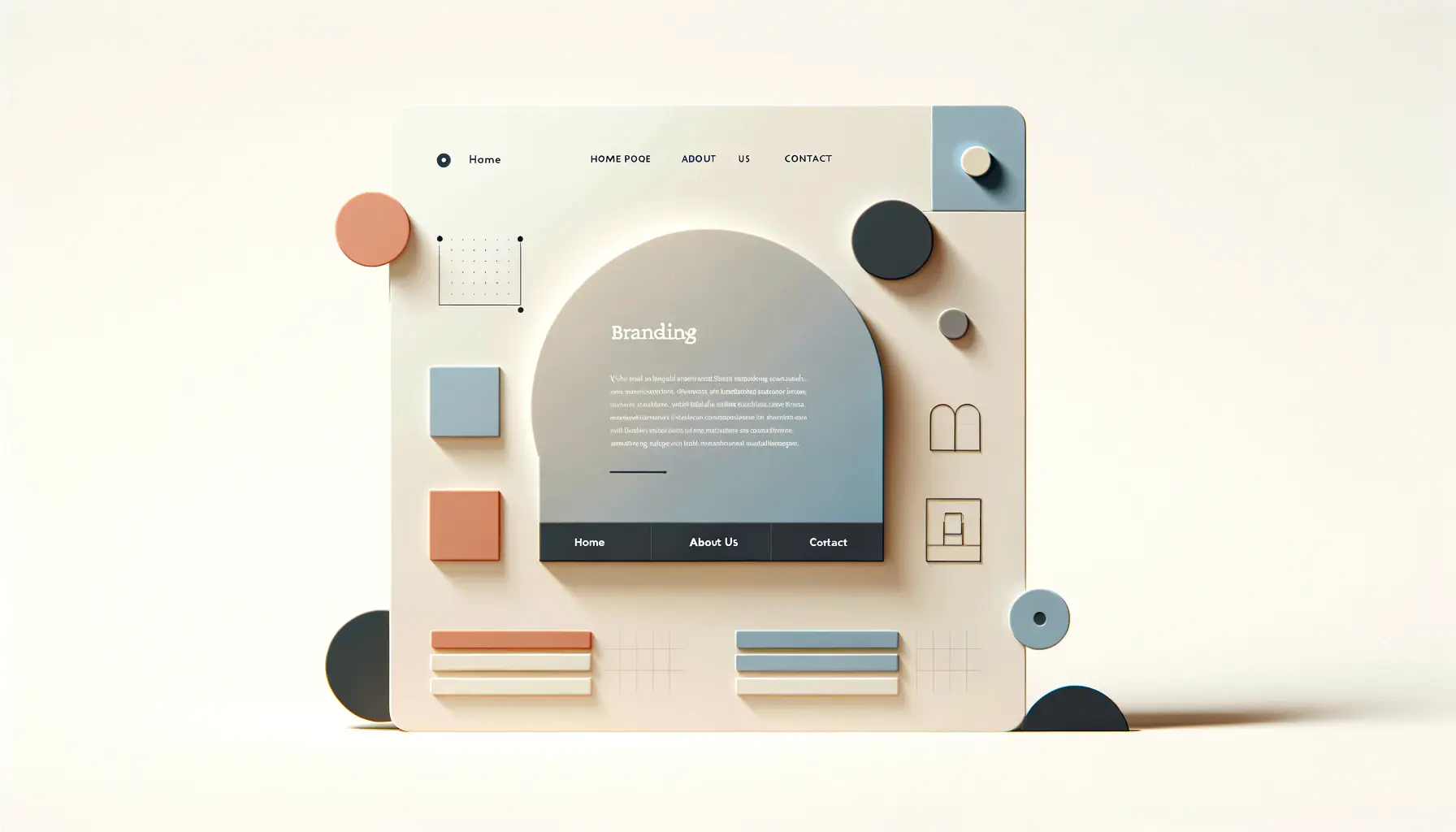In today’s digital age, the significance of feedback loops in web design branding cannot be overstated.
As businesses strive to establish a strong online presence, understanding and implementing effective feedback loops become crucial.
These mechanisms not only facilitate a deeper understanding of user interactions but also empower brands to refine and adapt their digital strategies in real-time.
By harnessing the power of feedback loops, companies can create more engaging, user-friendly, and successful web designs that resonate with their target audience.
At the heart of every successful web design branding strategy lies the ability to listen, interpret, and act on user feedback.
This continuous cycle of receiving and responding to user input is what defines a feedback loop.
In the context of web design, this means creating avenues for users to share their experiences, preferences, and suggestions, and then using that information to make informed decisions about design adjustments and enhancements.
The ultimate goal is to foster a positive user experience that aligns with the brand’s identity and values, thereby strengthening brand loyalty and recognition.
- Understanding Feedback Loops in Web Design
- Strategies for Implementing Feedback Loops
- Challenges and Solutions in Feedback Loop Integration
- Feedback Loop Tools and Technologies
- Incorporating User Feedback into Design Decisions
- Case Studies: Success Stories of Feedback Loops
- Future Trends in Feedback Loops and Web Design
- Conclusion: Harnessing the Power of Feedback Loops in Web Design Branding
- FAQs on Feedback Loops in Web Design Branding
Understanding Feedback Loops in Web Design
What Are Feedback Loops?
Feedback loops in web design refer to the systematic process of collecting user inputs, analyzing them, and then making necessary adjustments to the website based on that analysis.
This iterative process ensures that the website evolves in response to user needs and preferences, leading to a more effective and engaging online presence.
Feedback loops can be initiated through various methods, including user surveys, feedback forms, usability testing, and analytics tracking.
The implementation of feedback loops in web design branding is not just about rectifying issues or shortcomings; it’s about proactively seeking opportunities to enhance the user experience.
By continuously engaging with users and valuing their input, brands can create a sense of community and inclusivity around their digital platforms.
This approach not only improves the website’s functionality and aesthetic appeal but also reinforces the brand’s commitment to its audience.
Benefits of Feedback Loops
Integrating feedback loops into web design branding offers numerous benefits.
Firstly, it allows for real-time insights into user behavior and preferences, enabling brands to make data-driven decisions.
This agility in design adjustments can significantly improve user satisfaction and engagement rates.
Secondly, feedback loops contribute to a more personalized user experience.
By understanding and addressing individual user needs, brands can create more relevant and compelling content and design elements.
Moreover, feedback loops facilitate a culture of continuous improvement.
They encourage brands to remain adaptable and responsive to changing user expectations and technological advancements.
This not only ensures the website remains current and competitive but also fosters innovation within the brand’s digital strategy.
Additionally, feedback loops can enhance SEO performance by identifying and addressing usability issues that could affect search engine rankings.
Incorporating feedback loops into web design branding is essential for creating dynamic, user-centered websites that effectively convey the brand’s message and values.
Strategies for Implementing Feedback Loops
Implementing feedback loops in web design requires a strategic approach to ensure that the process is efficient, effective, and aligned with the brand’s objectives.
Here are key strategies to consider when integrating feedback loops into your web design branding efforts:
Establishing Clear Channels for Feedback Collection
For feedback loops to be successful, users must have easy and accessible ways to provide their input.
This can be achieved through:
- User surveys embedded directly on the website or sent via email.
- Interactive feedback forms that allow users to report issues or suggest improvements.
- Comment sections on blog posts or forums where users can share their thoughts and engage in discussions.
- Social media platforms, which can serve as valuable tools for gathering informal feedback and fostering community engagement.
Analyzing Feedback for Actionable Insights
Collecting feedback is only the first step.
The crucial part of the process involves analyzing the data to extract actionable insights.
This involves:
- Identifying common themes or patterns in user feedback that indicate areas for improvement.
- Using analytics tools to delve deeper into user behavior and preferences.
- Prioritizing feedback based on its potential impact on the user experience and the brand’s goals.
Iterative Design and Development
Feedback loops are inherently iterative, meaning that the web design process should be flexible and ongoing.
This includes:
- Implementing changes based on user feedback in a timely manner.
- Conducting A/B testing to compare different design elements and determine which performs better.
- Releasing updates in phases to continuously improve the website without overwhelming users with drastic changes.
Communicating Changes to Users
Once changes have been made based on user feedback, it’s important to close the loop by communicating these updates back to the users.
This can be done through:
- Update logs or news sections on the website.
- Email newsletters highlighting recent improvements and thanking users for their contributions.
- Social media posts that engage the community and encourage further feedback.
Effective feedback loops are built on a foundation of open communication, user engagement, and a commitment to continuous improvement. By strategically implementing these loops, brands can create more meaningful and user-friendly web experiences.
Challenges and Solutions in Feedback Loop Integration
While the benefits of integrating feedback loops into web design branding are clear, several challenges can arise during implementation.
Recognizing these challenges and preparing solutions in advance can help ensure the success of feedback loops within your web design strategy.
Overcoming User Feedback Overload
One common challenge is managing and prioritizing a large volume of feedback.
This can be overwhelming, especially for smaller teams.
Solutions include:
- Utilizing feedback management tools that can help categorize and prioritize feedback based on predefined criteria.
- Setting up automated responses for common feedback themes to efficiently address user concerns.
- Engaging in direct communication with users for more complex issues, ensuring they feel heard and valued.
Ensuring Quality and Relevance of Feedback
Not all feedback is created equal.
Some may be irrelevant or not actionable.
To ensure the quality and relevance of feedback, consider:
- Implementing targeted surveys that ask specific questions related to recent updates or features.
- Encouraging detailed feedback by asking open-ended questions and providing examples of useful feedback.
- Training customer service teams to identify and escalate high-quality feedback for further analysis.
Maintaining User Engagement and Participation
Another challenge is encouraging ongoing user engagement and participation in the feedback process.
Strategies to maintain user interest include:
- Offering incentives for feedback, such as discounts, access to beta features, or public recognition.
- Highlighting how user feedback has led to tangible improvements on the website or in the service.
- Creating a user community where feedback is regularly requested and discussed, fostering a sense of ownership and involvement.
Aligning Feedback with Brand Goals
Ensuring that feedback aligns with the brand’s long-term goals and vision can be challenging.
To achieve this alignment:
- Establish clear objectives for each feedback loop, ensuring they contribute to the overall brand strategy.
- Involve stakeholders from different departments in the feedback analysis process to gain diverse perspectives.
- Regularly review and adjust feedback mechanisms to ensure they remain focused on areas of strategic importance.
Addressing these challenges requires a proactive and strategic approach. By implementing effective solutions, brands can maximize the benefits of feedback loops in enhancing their web design and overall user experience.
Feedback Loop Tools and Technologies
Incorporating feedback loops into web design branding efficiently requires leveraging the right tools and technologies.
These solutions can streamline the process of collecting, analyzing, and acting on user feedback.
Here’s a look at some essential tools and technologies that can facilitate effective feedback loops:
Survey and Feedback Collection Tools
Tools designed for survey creation and feedback collection are fundamental in establishing feedback loops.
They offer features like:
- Customizable survey templates that can be tailored to specific feedback needs.
- Integration capabilities with websites and email platforms for easy distribution and collection.
- Analytics features for summarizing feedback and identifying trends.
Examples of these tools include SurveyMonkey, Google Forms, and Typeform, each offering unique functionalities to suit different feedback collection needs.
Customer Relationship Management (CRM) Systems
CRM systems play a crucial role in managing user feedback, especially in terms of personalization and follow-up.
They allow brands to:
- Store and manage detailed user profiles, including feedback history.
- Segment users based on feedback, enabling targeted responses and improvements.
- Automate follow-up communications to keep users engaged and informed about changes.
Popular CRM platforms like Salesforce and HubSpot offer robust features for feedback management within a broader customer relationship strategy.
User Behavior Analytics Tools
To complement direct user feedback, analytics tools that track user behavior on a website can offer invaluable insights.
These tools help by:
- Providing data on how users interact with different elements of a website.
- Identifying potential usability issues that might not be explicitly mentioned in user feedback.
- Offering A/B testing capabilities to evaluate the effectiveness of design changes.
Google Analytics and Hotjar are examples of analytics tools that can enhance feedback loops by adding a layer of behavioral insight.
Project Management and Collaboration Tools
Feedback loops require coordination across multiple teams within an organization.
Project management and collaboration tools facilitate this by:
- Enabling the creation of tasks and projects based on user feedback.
- Allowing teams to collaborate on feedback analysis and implementation strategies.
- Tracking progress on feedback-related initiatives and ensuring accountability.
Tools like Trello, Asana, and Slack are essential for maintaining organization and transparency throughout the feedback loop process.
Choosing the right mix of tools and technologies is crucial for implementing effective feedback loops. By leveraging these solutions, brands can create a structured and efficient process for turning user feedback into actionable insights and improvements.
Incorporating User Feedback into Design Decisions
Effectively incorporating user feedback into web design decisions is a critical step in the feedback loop process.
It ensures that the insights gathered directly influence the website’s evolution, making it more user-centric and aligned with audience needs.
Here’s how to integrate user feedback into design decisions effectively:
Firstly, it’s essential to establish a systematic approach to collecting and organizing feedback.
This involves categorizing feedback into different types, such as usability issues, feature requests, or content suggestions.
By doing so, you can more easily identify which areas of your website require immediate attention and which suggestions could be considered for future updates.
Setting Priorities Based on User Feedback
Not all feedback will have the same level of urgency or impact on your web design.
To manage this, you should:
- Assess the potential impact of each piece of feedback on the user experience and your brand objectives.
- Prioritize feedback that addresses critical usability issues or enhances key functionalities.
- Consider the resources required to implement changes and focus on those that offer the best return on investment.
Engaging in User-Centric Design Iterations
Feedback should be the driving force behind design iterations.
This means:
- Implementing changes based on feedback and then testing these changes with users to ensure they effectively address the initial concerns.
- Using prototypes and mockups to visualize changes and gather more targeted feedback before full-scale implementation.
- Continuously iterating on design elements based on ongoing user feedback to refine and improve the user experience over time.
Communicating Changes to Users
Once changes are made based on user feedback, it’s crucial to close the loop by informing users about the updates.
This can be achieved through:
- Update notifications on the website or through email newsletters.
- Engagement posts on social media highlighting the changes made and inviting further feedback.
- Feature release notes that detail the improvements and the user feedback that inspired them.
By incorporating user feedback into design decisions and communicating these changes back to the user base, brands can foster a sense of community and co-creation.
This not only enhances the website’s effectiveness but also builds stronger relationships with the audience.
True engagement with user feedback transforms the web design process into a dynamic, user-driven endeavor. It ensures that the website continuously evolves in ways that genuinely meet user needs and expectations, thereby strengthening the brand’s online presence.
Case Studies: Success Stories of Feedback Loops
Examining real-life examples of feedback loops in action can provide valuable insights into their potential impact on web design branding.
These case studies highlight how businesses have successfully integrated feedback loops into their strategies, leading to significant improvements in user experience and brand perception.
Enhancing User Experience Through Direct Feedback
A leading e-commerce platform implemented a feedback loop by introducing a simple feedback widget on their product pages.
This allowed users to report issues or suggest improvements directly related to the products they were interested in.
By analyzing this feedback, the company identified a common request for more detailed product images and descriptions.
Acting on this insight, they enhanced their product pages with high-resolution images and more comprehensive descriptions, leading to a noticeable increase in user engagement and conversion rates.
This change not only improved the user experience but also reinforced the brand’s commitment to customer satisfaction.
Revamping a Website Based on User Insights
An educational institution sought to update its website to better serve prospective students.
Through surveys and usability testing, they gathered feedback indicating that users found the site difficult to navigate and lacking in relevant information about programs and admissions.
In response, the institution redesigned its website with a more intuitive navigation structure and added detailed sections on programs, admissions processes, and student life.
Post-launch feedback confirmed that the new design significantly improved user satisfaction and helped prospective students find the information they needed more efficiently.
Improving Product Discovery with User-Generated Content
A lifestyle brand recognized the importance of user-generated content in enhancing product discovery on their website.
They encouraged users to submit reviews and photos of their products in use.
Feedback loops were used to identify the most popular products and themes in user submissions.
The brand then featured this user-generated content prominently on their website, creating a more engaging and relatable shopping experience.
This approach not only boosted sales but also fostered a strong sense of community among the brand’s customers.
These case studies demonstrate the transformative power of feedback loops in web design branding. By actively listening to and acting on user feedback, brands can create more engaging, effective, and user-friendly websites that drive business success and enhance brand loyalty.
Future Trends in Feedback Loops and Web Design
The digital landscape is constantly evolving, and with it, the strategies for integrating feedback loops into web design branding.
Staying ahead of these trends is crucial for businesses looking to maintain a competitive edge and foster a positive user experience.
Here are some future trends in feedback loops and web design that brands should be aware of:
Artificial Intelligence and Machine Learning
Artificial intelligence (AI) and machine learning (ML) technologies are set to play a significant role in automating and enhancing feedback loop processes.
These technologies can help by:
- Analyzing large volumes of user feedback more efficiently, identifying patterns and insights that might be missed by human analysis.
- Personalizing user experiences in real-time based on feedback and behavior, creating a more dynamic and responsive web design.
- Automating responses to common feedback themes, allowing brands to address user concerns more quickly and effectively.
Increased Focus on User-Generated Content
User-generated content (UGC) is becoming an increasingly important element of web design branding, offering authentic insights into user preferences and experiences.
Future trends include:
- Encouraging users to share their experiences, reviews, and content directly on the website, enhancing the sense of community and trust.
- Using UGC to inform design decisions, ensuring that web designs are closely aligned with user expectations and needs.
Greater Integration with Social Media Platforms
Social media platforms are valuable sources of user feedback and engagement.
Trends in integrating these platforms with web design include:
- Embedding social media feeds and user comments directly on the website, providing real-time insights into user sentiment.
- Utilizing social media analytics to inform web design decisions, ensuring that designs resonate with the target audience’s preferences on these platforms.
Emphasis on Ethical Design and Privacy
As users become more concerned about their digital privacy and the ethical implications of web design, feedback loops will need to adapt.
This includes:
- Designing feedback mechanisms that respect user privacy and data protection regulations.
- Using feedback to create more inclusive, accessible, and ethically responsible web designs.
By keeping an eye on these future trends, brands can ensure that their feedback loops and web design strategies remain effective, relevant, and aligned with user expectations.
Embracing innovation and adapting to changes in the digital landscape will be key to creating engaging and successful online experiences.
The future of feedback loops in web design branding lies in leveraging technology to enhance user engagement, ensuring ethical design practices, and adapting to the ever-changing digital environment. By staying informed and flexible, brands can continue to harness the power of feedback loops to drive growth and user satisfaction.
Conclusion: Harnessing the Power of Feedback Loops in Web Design Branding
The journey through the intricacies of feedback loops in web design branding reveals a landscape where user engagement, technological innovation, and strategic implementation converge to create dynamic and responsive web experiences.
As we’ve explored, the essence of feedback loops lies in their ability to foster a continuous dialogue between users and brands, enabling the latter to adapt and evolve in alignment with user needs and preferences.
This process is not just about rectifying shortcomings but about seizing opportunities to innovate and enhance the web design branding strategy.
Key Takeaways
From the strategic implementation of feedback loops to overcoming challenges and leveraging future trends, several key takeaways emerge:
- Feedback loops are indispensable for understanding and meeting user expectations, thereby enhancing user satisfaction and loyalty.
- The integration of AI and ML, along with an increased focus on UGC and social media integration, represents the future of feedback loops in web design.
- Adapting to ethical design and privacy concerns within feedback mechanisms will be crucial in maintaining user trust and compliance with regulations.
Strategic Implementation for Future Success
For brands looking to thrive in the digital realm, the strategic implementation of feedback loops in web design branding is not optional but essential.
It requires a commitment to listening, a willingness to adapt, and the foresight to anticipate and respond to future trends.
By doing so, brands can ensure that their web presence is not only visually appealing and aligned with their identity but also resonates with their target audience on a deeper level.
In conclusion, the importance of feedback loops in web design branding cannot be overstated.
They are the lifeline that connects brands with their users, guiding them through the ever-evolving digital landscape.
As we move forward, the brands that will stand out are those that not only listen to their users but also act on their feedback in meaningful ways.
In this dynamic interplay of feedback and design, the potential for innovation and growth is boundless, paving the way for web experiences that are not only functional and beautiful but also deeply connected with the needs and aspirations of users.
Quality web design is key for a great website! Check out our service page to partner with an expert web design agency.
FAQs on Feedback Loops in Web Design Branding
Explore commonly asked questions about integrating feedback loops into web design branding to enhance user experience and brand identity.
A feedback loop in web design is a process of collecting user feedback, analyzing it, and making design improvements based on insights gathered.
Feedback loops are vital for understanding user needs, enhancing functionality, and fostering innovation in web design branding.
By addressing user feedback, feedback loops can lead to a more intuitive and satisfying user experience, increasing engagement and loyalty.
Surveys, user testing, feedback forms, and analytics tools are common methods for collecting valuable user feedback in web design.
Feedback is categorized, prioritized, and analyzed for patterns or common issues that guide actionable design improvements.
Yes, by enhancing user experience and site usability, feedback loops can positively impact SEO rankings and web visibility.
Feedback loops should be ongoing to continuously adapt to user needs and evolving web design trends for optimal performance.
Challenges include managing overwhelming feedback, ensuring feedback quality, and aligning changes with brand goals and resources.











